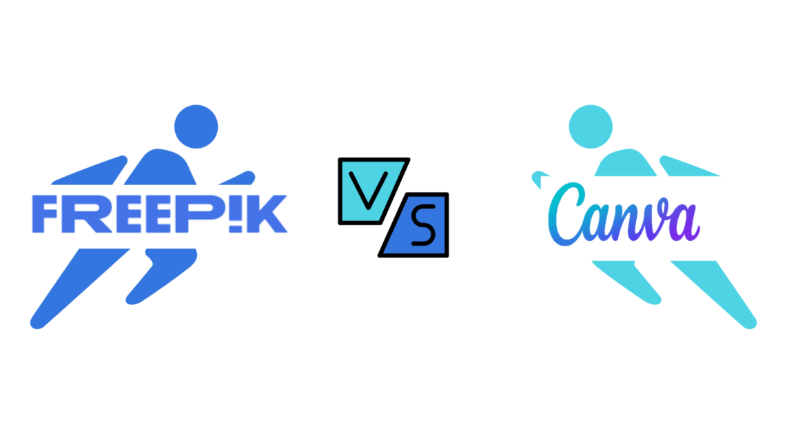Struggling to choose the right design tool for your next project? Deciding between Canva's intuitive interface and Freepik's vast asset library can feel overwhelming.
What You'll Learn:
- The core differences and strengths of Canva and Freepik.
- How to effectively get started with each platform.
- Best practices for maximizing your design workflow with both tools.
- The expected outcomes and success metrics for leveraging Canva and Freepik.
- Actionable tips to elevate your designs in 2025.
Understanding Canva vs. Freepik
When embarking on a design journey, selecting the right platform is paramount. Canva and Freepik, while both serving the design community, cater to different needs and offer distinct experiences. Understanding their fundamental differences will pave the way for more efficient and effective design work.
Canva vs. Freepik Fundamentals
Canva is primarily an all-in-one design platform. It provides users with a user-friendly drag-and-drop interface, pre-designed templates, and a library of elements (photos, icons, fonts) to create a wide range of visual content. It's often favored by individuals and small businesses looking for ease of use and quick design creation.
Freepik, on the other hand, is a massive online resource for graphic design assets. Its core offering is a vast collection of free and premium vectors, illustrations, photos, mockups, and PSD files. While Freepik does offer some editing capabilities and integrations, its primary strength lies in its extensive asset library, serving as a go-to for designers seeking specific graphical elements to incorporate into their projects.
Key Concepts
Here's a breakdown of the core concepts associated with each platform:
- Canva:
- Template-driven design: Focuses on adapting existing layouts.
- Integrated editor: All tools are within one application.
- Collaboration features: Easy sharing and teamwork.
- Brand Kit: Storing brand assets for consistent branding.
- Freepik:
- Asset-centric approach: Primarily about sourcing high-quality graphics.
- Extensive library: Millions of downloadable resources.
- File diversity: Offers various file formats suitable for different design software.
- Attribution requirements: Free assets often require creator credit.
“Canva empowers beginners to create professional-looking designs quickly, while Freepik provides the raw materials for seasoned designers to build something truly unique.”
Canva vs. Freepik Implementation
Successfully integrating Canva and Freepik into your design workflow requires understanding how to get started and adopting best practices for each.
Getting Started
Canva:
- Sign Up/Log In: Visit Canva.com and create a free account or log in.
- Choose a Template or Blank Canvas: Browse thousands of templates for social media, presentations, posters, and more, or start from scratch.
- Drag and Drop Elements: Utilize the extensive library of photos, graphics, text, and backgrounds.
- Customize: Adjust colors, fonts, sizes, and add your own uploads.
- Download/Share: Export your design in various formats or share it directly.
Freepik:
- Sign Up/Log In: Visit Freepik.com and create a free or premium account.
- Search for Assets: Use keywords to find vectors, photos, icons, mockups, etc.
- Filter Results: Refine your search by file type, orientation, color, or free/premium status.
- Download: Click the download button for your chosen asset. For free assets, note any attribution requirements.
- Import into Design Software: Open the downloaded file in your preferred design tool (e.g., Adobe Photoshop, Illustrator, or even Canva).
Best Practices
To maximize your design output and efficiency:
- For Canva:
- Leverage Templates: Don't reinvent the wheel. Adapt templates to fit your brand and message.
- Use the Brand Kit: Upload your logos, brand colors, and fonts for consistent branding across all designs.
- Organize Your Projects: Use folders to keep your designs tidy.
- Explore Integrations: Connect Canva with other tools you use for a seamless workflow.
- For Freepik:
- Understand Licensing: Always check the license for each asset, especially for commercial use. Free assets often require attribution.
- Master Search Terms: Use specific and varied keywords to find exactly what you need.
- Combine Assets: Don't be afraid to combine multiple Freepik assets to create something original.
- Edit and Adapt: Downloaded vectors are often fully editable, allowing you to change colors, shapes, and details.
Here's a comparison of their core features:
| Feature | Canva | Freepik |
| Primary Function | All-in-one design editor & platform | Asset library for design resources |
| Ease of Use | Very High (beginner-friendly) | Moderate (depends on design software used) |
| Asset Library | Integrated, curated, but smaller | Vast, diverse, millions of assets |
| Templates | Extensive, categorized, editable | Limited, often within asset packs |
| Editing Tools | Built-in drag-and-drop, basic editing | Relies on external design software |
| Pricing Model | Freemium (Free & Pro versions) | Freemium (Free & Premium subscriptions) |
| Best For | Social media, presentations, quick graphics | Graphic elements, illustrations, photos, mockups |
“When I need to quickly whip up social media graphics with a consistent brand feel, Canva is my go-to. For unique illustrations or complex photo manipulations, I head straight to Freepik.”
Canva vs. Freepik Benefits and Results
The strategic use of Canva and Freepik can lead to significant improvements in design quality, efficiency, and overall project success.
Expected Outcomes
By strategically employing both Canva and Freepik, you can anticipate the following positive outcomes:
- Enhanced Design Quality: Access to a wider range of high-quality assets and user-friendly tools leads to more polished and professional-looking designs.
- Increased Design Efficiency: Streamlined workflows, pre-made templates, and vast asset libraries significantly reduce the time spent on design tasks.
- Consistent Branding: Tools like Canva's Brand Kit and the ability to source consistent styles from Freepik ensure brand uniformity.
- Cost-Effectiveness: Both platforms offer robust free tiers, and their premium options are often more affordable than hiring a full-time designer for every task.
- Creative Freedom: Combining the ease of Canva with the expansive library of Freepik allows for greater creative exploration and unique visual solutions.
Success Metrics
Measuring the impact of using Canva and Freepik can be done through various metrics:
- Time Saved: Track the reduction in design creation time compared to previous methods.
- Project Completion Rate: Observe an increase in the number of design projects completed within deadlines.
- Engagement Metrics: For digital content, monitor improvements in likes, shares, clicks, and conversions attributed to better-designed visuals.
- Brand Recognition: Assess if consistent branding across platforms leads to improved brand recall.
- Cost Savings: Calculate the reduction in expenses related to design software, stock photos, or freelance designers.
“Since integrating Freepik assets into my Canva designs, I've seen a noticeable uptick in social media engagement. The custom illustrations I can now create are far more eye-catching than generic stock photos.”
FAQ (Frequently Asked Questions)
Frequently Asked Questions
Q: Can I use Freepik assets in Canva?
A: Yes, absolutely! You can download assets from Freepik (vectors, photos, etc.) and upload them directly into your Canva projects. This is a powerful way to combine Freepik's vast asset library with Canva's intuitive design interface.
Q: What's the main difference between Canva Pro and Freepik Premium?
A: Canva Pro unlocks premium templates, photos, and features within the Canva editor, focusing on enhancing the user's design experience and output. Freepik Premium grants unlimited downloads of premium assets from their library and removes attribution requirements, focusing on providing a wider selection of high-quality graphic resources.
Q: Do I need to pay for Canva or Freepik to create good designs?
A: Not necessarily. Both platforms offer excellent free versions that are sufficient for many users and projects. The premium versions offer more advanced features and resources, which can be beneficial for professional or high-volume design needs.
Q: What types of files can I download from Freepik?
A: Freepik offers a wide variety of file types, including JPG, PNG, SVG, AI, EPS, PSD, and more, depending on the specific asset. This versatility allows you to use them in various design software.
Choosing between Canva and Freepik, or more accurately, learning to leverage both, is key to elevating your design game in 2025. Canva offers a streamlined, all-in-one solution perfect for quick creations and consistent branding, while Freepik provides an unparalleled library of graphic assets that can transform any project. By understanding their individual strengths and implementing them strategically, you can achieve higher quality designs, boost your efficiency, and ultimately, drive better results.
Ready to create stunning visuals? Start exploring Canva and Freepik today!







